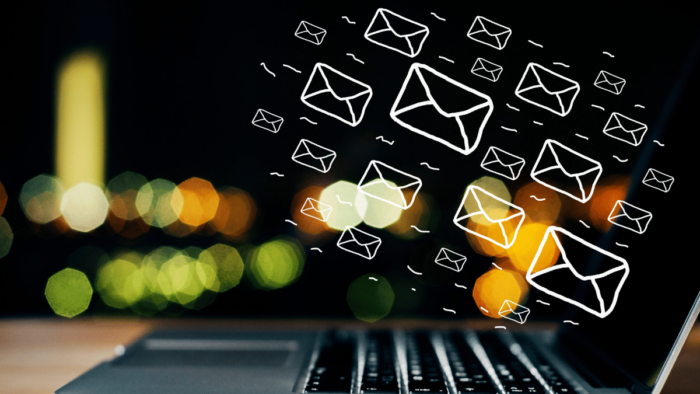Are you using email marketing as part of your marketing strategy? Do you have a specific email marketing strategy? If so, are your email marketing campaigns successful?
It’s easy to make many mistakes with email marketing. Though it seems simple, getting your emails just right for your target audience takes time and skill.
Email marketing is the basis for your business to communicate with potential customers.
Here, I will explain everything related to using email campaigns as part of your email marketing strategy. Whether you are a startup entrepreneur, digital marketer, or marketing manager, this guide will help you develop a systematic approach to using successful email marketing campaigns.
📖 Key Takeaways
- Email marketing is still a reliable way to effectively engage an audience in the digital world of distractions we live in today.
- Different email marketing campaign types serve different purposes, from confirmation and a welcome email to engagement and promotional campaigns.
- To have a successful campaign, you must follow nine steps. For an effective campaign, you must plan its purpose, content, and timing while continuously analyzing performance for improvements.
Is Email Marketing Still Effective?
Email is the most effective form of communication regarding marketing, selling your products and services, or reaching your customer base. While some may discount it in favor of social media, email is still essential today.
Let’s examine a few reasons why.
Reach and impact
Email marketing has the potential for massive reach. If you have a subscriber list, you have essentially captured some target audience.
Most people (99%) check their emails multiple times a day, and while email clients like Gmail will filter promotional emails, many people still check these looking for bargains.
You’ll likely seize a lead if you can offer a discount, free shipping, free quotes, or any other attractive offer via your successful email marketing campaign.
Improved brand awareness and position
If you send regular marketing emails to your subscribers, you’re effectively and efficiently positioning your brand in front and at the center of your audience. People will remember your brand name and identity and associate it with your product or service.
Namely, over 90% of surveyed professionals affirm that their email marketing strategy is crucial to their company’s overall success; this is a strong signal that it plays a key role in building brand awareness and maintaining customer relationships.
Email is an affordable marketing solution
Unlike paid search, social media advertising, and broadcast, email marketing is quick, easy, and affordable.
According to Statista, email marketing revenue worldwide is expected to grow $17.9 billion in 2027 from $7.5 billion in 2020. Also, as of June 2020, companies make an average of $36 for every U.S. dollar they spend on email marketing.
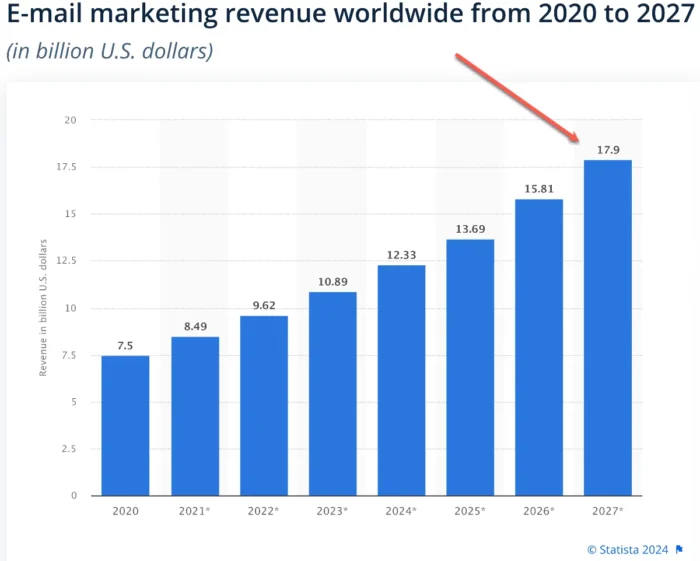
Some studies even suggest that email marketing ROI can reach 4400%, far surpassing other marketing channels in terms of cost-effectiveness and return.
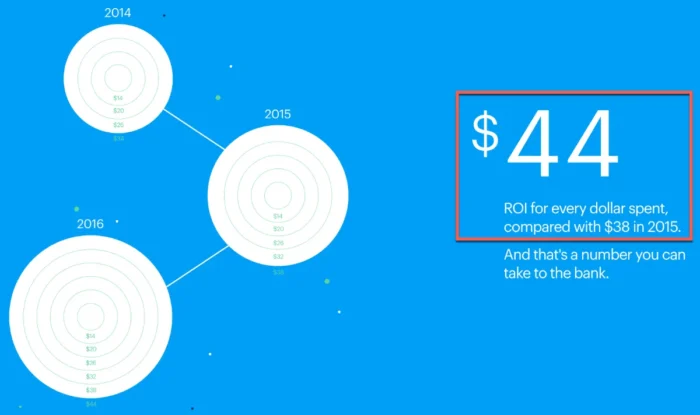
These numbers confirm that email campaigns are still the most cost-effective marketing channel and approach.
Purpose of Email Marketing Campaigns
The primary goal of email marketing campaigns can vary significantly depending on a company’s specific objectives.
Here, I would like to share several key purposes that you can consider before you start developing your email campaign:
1. Build relationships
Email marketing is one of the best marketing tactics for building and nurturing long-term customer relationships.
You can improve customer loyalty and engagement by directly providing valuable content, updates, and highly personalized offers to your subscribers and current or potential customers.
In 2021, Statista revealed that 46% of customers favored email as their primary communication channel.
Furthermore, a 2022 survey among US consumers showed that 34% preferred brands to reach out to them through social media. However, more than double that number advocated for email as the preferred communication medium with brands.
2. Drive sales (promotion)
Email marketing campaigns are highly effective for promotions, special offers, or product launches to help you increase sales.
For example, during Black Friday and Cyber Monday, email marketing contributed significantly to online sales, with Campaign Monitor reporting that email marketing drove over 20% of online holiday site visits.
3. Better brand recognition
Regular, valuable emails with strong brand consistency help you keep your brand in front of your consumers’ eyes.
The more they engage with your brand, the easier it becomes for them to recognize you and make a purchase or inquiry when they need something you are offering.
4. Customer feedback and insights
An email marketing campaign can easily provide a direct line for you to collect customer feedback, whether through surveys, polls, or simple reply-to requests.
This feedback is valuable for improving your products, services, and overall customer experience.
5. Increase traffic to your website
Also, an email marketing campaign can significantly increase web traffic by including links to your website, blog, or specific landing pages. Engaged readers will then be led to more detailed content, product listings, or services, potentially increasing conversions.
6. Segment audience in different segments
Email marketing allows you to easily segment your subscribers and send adjusted messages to specific groups for more personalized communication.
Mailchimp’s data from 2017 shows that segmented campaigns can lead to a 14.31% higher open rate than non-segmented campaigns.
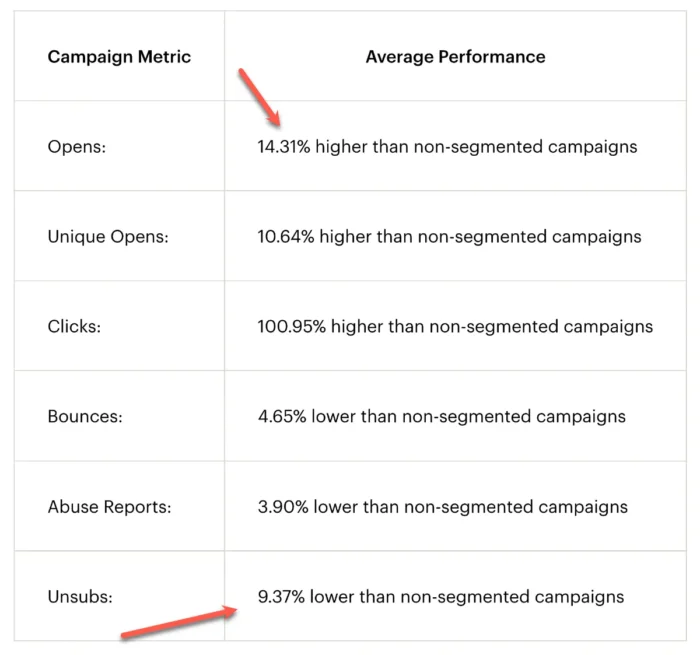
Types of Email Marketing Campaigns
Email marketing campaigns can vary greatly depending on the goals of the marketer. Below are some common types of emails, from the first welcome email to re-engagement emails usually used in email marketing campaigns:
1. Confirmation Emails
This is your autoresponder software’s first email to each new subscriber in a specific email marketing campaign.
The goal is to confirm that each subscriber wants to receive emails from you in the future until they unsubscribe from your list.
You will use confirmation emails using a double opt-in approach, which is highly recommended for your campaigns. This approach requires the email owner or the person who has access to the email account to confirm that they want to receive emails from your company.
Here is an example from ConvertKit where these emails are called “Incentive Emails.”

You can also use this template to improve and make your potential clients’ first impressions more professional. If you promote your personal brand, you can add an image, a company logo, or your own image.
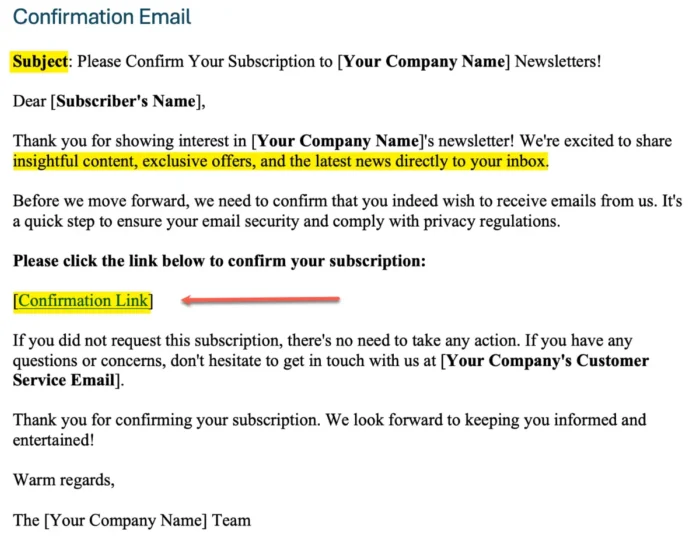
2. Welcome Emails
Welcome emails are the first interactions your business will make with a new subscriber who has confirmed joining your list or specific email marketing campaign. They are important because they explain what new recipients can expect from you in the future.
The welcome email is also a great opportunity to express your brand’s personality and values.
Here is one great example that can give you an idea of how to design your welcome email.
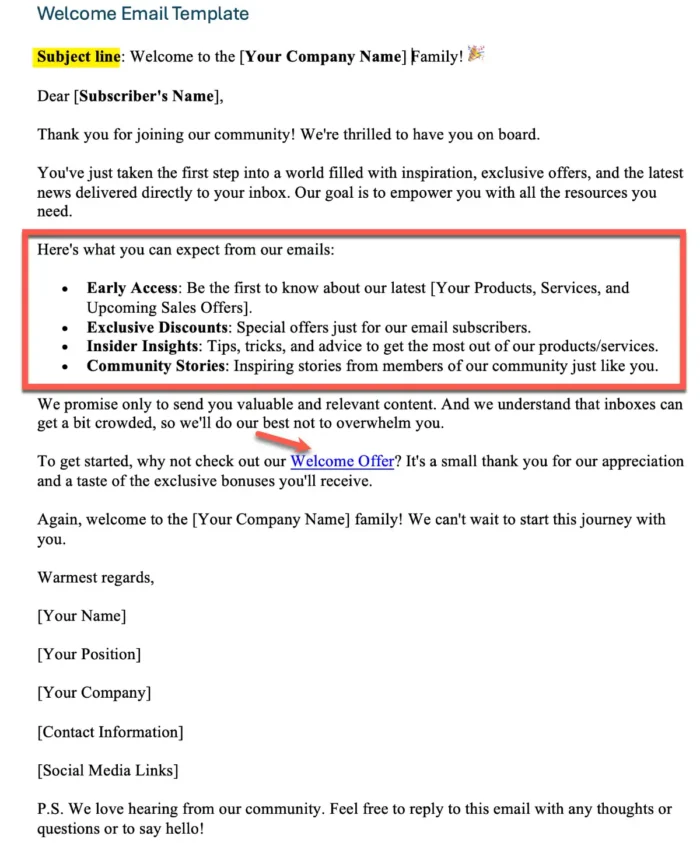
3. Awareness and engagement email campaigns
The engagement email marketing campaign strengthens the relationship between your brand and its recipients, encouraging active participation, feedback, and sustained interest in your offerings. These emails can also help you increase awareness of your offerings and the company’s existence.
Remember, these are not promotional emails but emails that will educate and engage your subscribers.
Here are some awareness and engagement email marketing campaign examples:
Newsletter email marketing campaign
Regular newsletters help keep your audience engaged by sharing recent updates, news, or blog post articles. They’re effective for keeping your brand at the top of your subscribers’ minds.
Here is one newsletter email marketing campaign example:
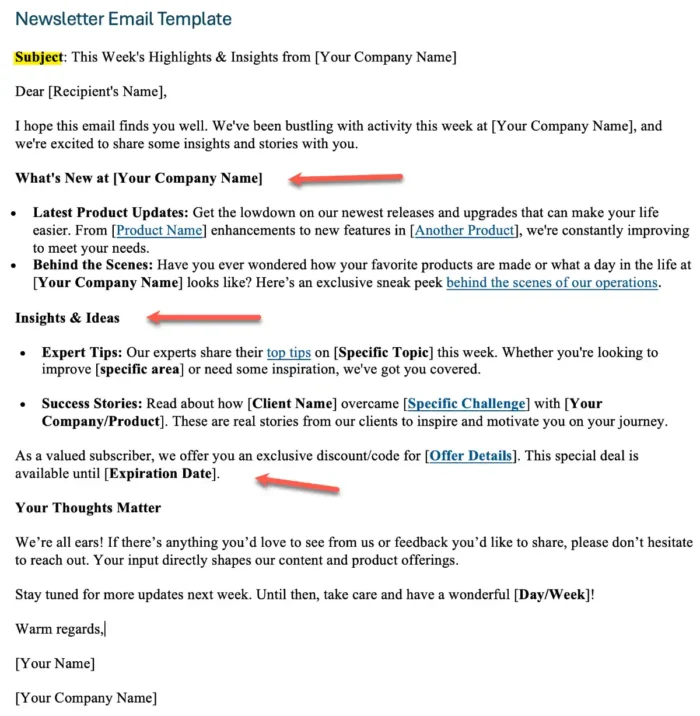
Educational email campaigns
Educational campaigns must provide valuable information, educational content, or tips related to your industry that can help your subscribers.
For example, you can send emails with tutorials on how current or potential customers can use your product more effectively. You can also send links to a how-to blog post.
You can prepare a series of emails as a part of sequences inside your automated emails to be sent one by one after some period of time. So, your email marketing service provider will send them an automated email for that time.
Here is a template you can use to activate your subscribers in such educational campaigns.
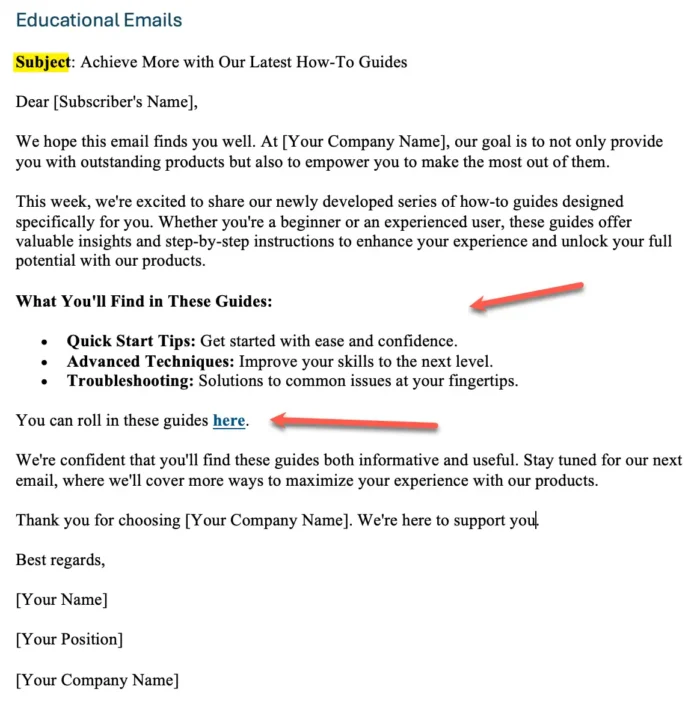
Case studies
Case study campaigns focus on one specific product or service, detailing its features, benefits, and use cases by your existing customers to educate your audience.
If you share success stories or testimonials from happy customers, you can encourage the interest of your recipients to learn more about your products or services.
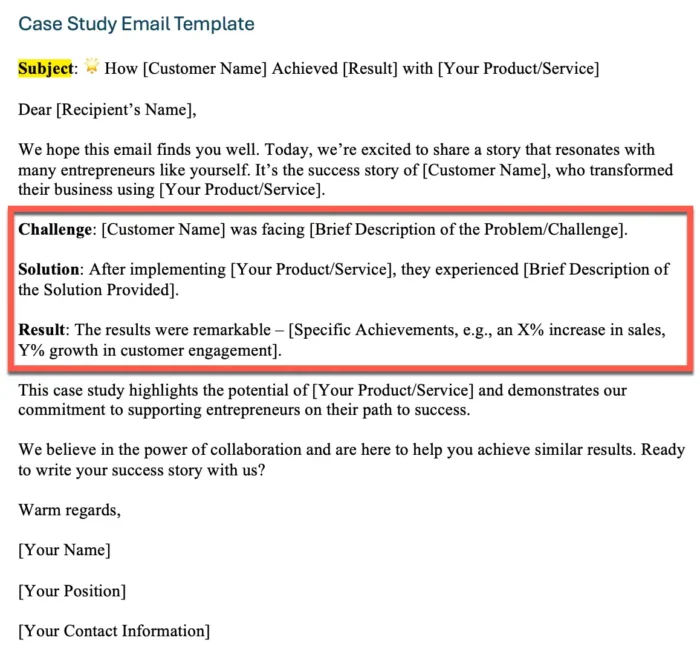
Feedback or survey emails
These emails aim to get opinions or feedback from your customers regarding their experience with your product, service, or recent interaction with your brand. You want to learn more from your subscribers.
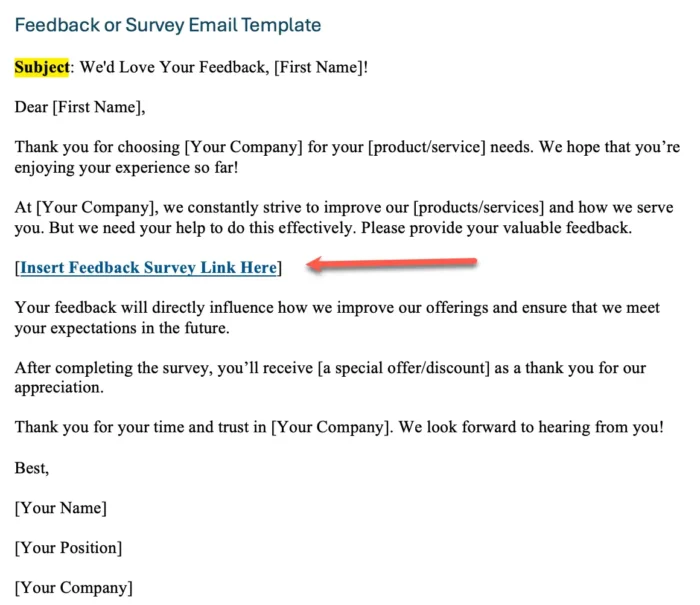
Re-engagement emails
If you want successful email marketing campaigns, you must ensure your subscribers’ list is engaged. The best approach is to target inactive subscribers with messages designed to re-engage them with your content or offerings.
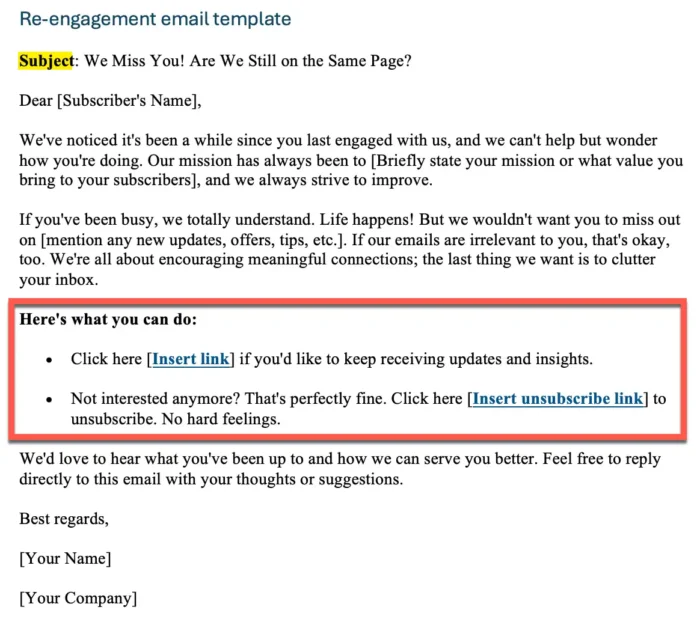
4. Marketing Emails or Customer Appreciation Emails
With these types of emails, you want to show your gratitude to your customers for their loyalty by offering them exclusive discounts or early access to new products or services.
You can use these email marketing campaign examples for this category to develop your own emails:
Promotional email campaign
As the name suggests, a promotional email promotes a specific product, service, or event, often including a special offer, post-purchase drip email, or discount to encourage the subscriber to take action.
Here is an example of a promotional email template you can use:
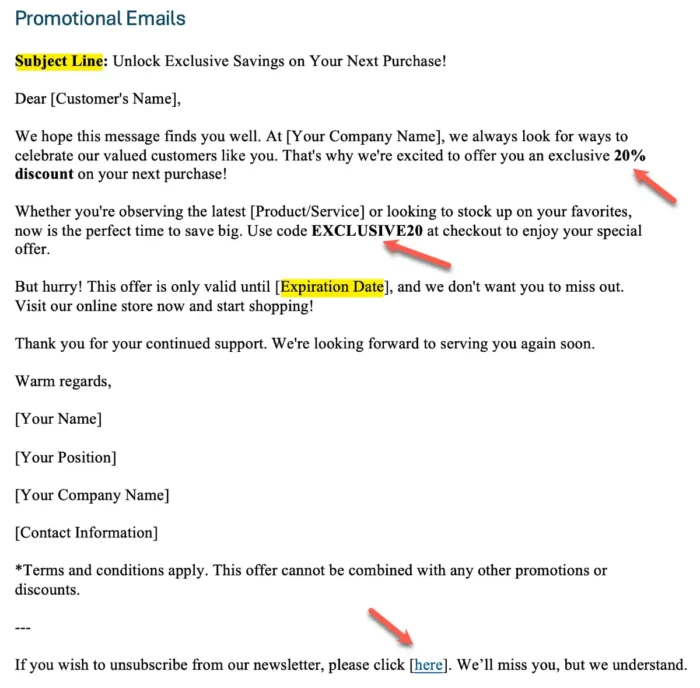
Seasonal email campaigns
Conversely, seasonal campaign emails are sent during specific seasons or holidays, such as Christmas or Black Friday. They are usually promotional, offering special deals or highlighting seasonal products.
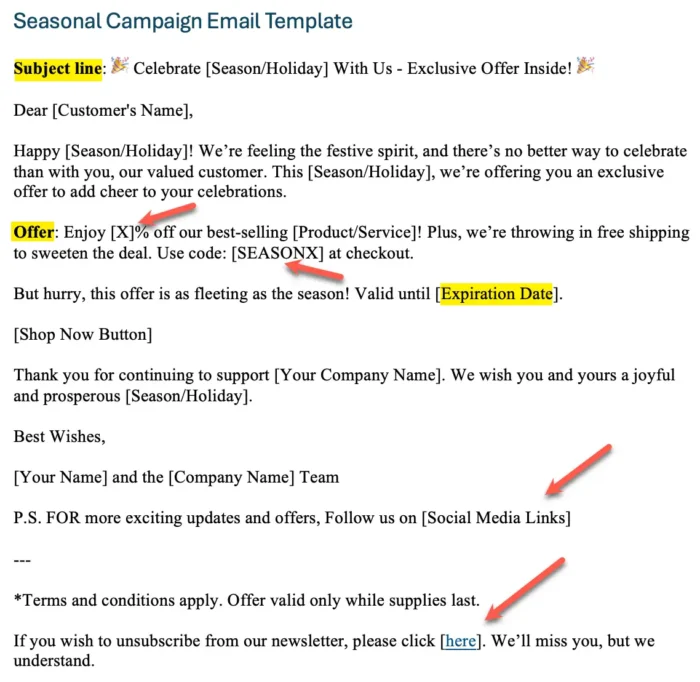
Early access email
You can also appreciate customers and make them feel valued by sending them early access to new products or services.
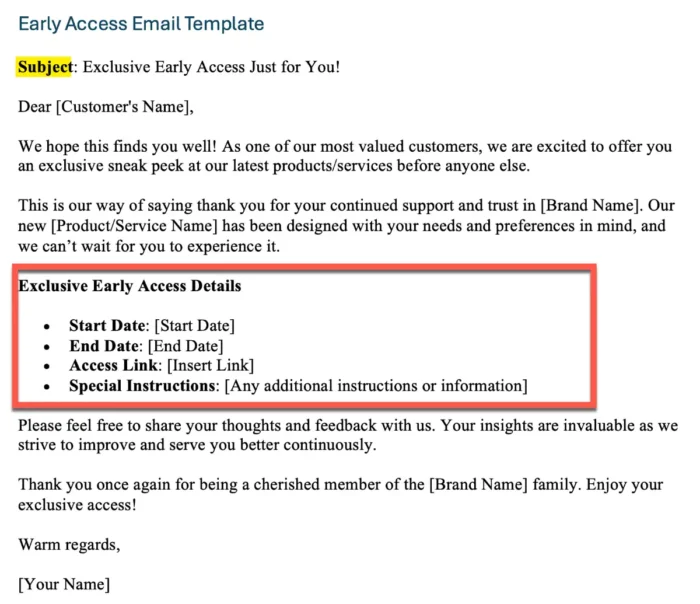
5. Announcement Emails
These emails are related to updates, releases, or changes within your company or product lineup to your audience.
For example, you can introduce your audience to a new offering, highlighting its features, benefits, and any introductory offers to spark interest and drive early adoption. Price changes and company news can also be part of these types of emails.
6. Transactional Emails
Transactional emails are triggered by your customers’ actions, such as purchasing or resetting their passwords. They have a specific functional purpose but can also promote related products or services.
Some examples of these emails are:
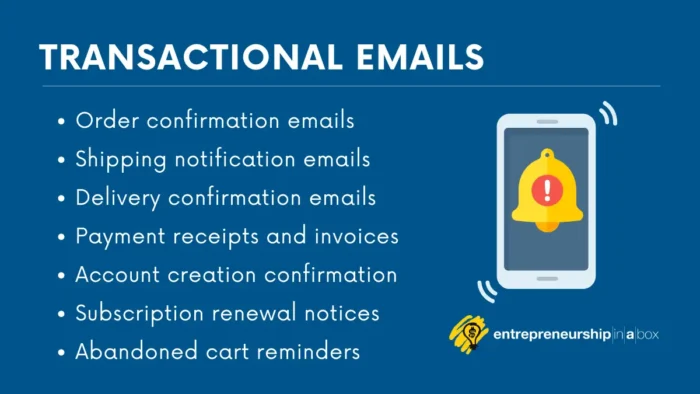
How to Create a Successful Email Marketing Campaign?
I have been online since 2007, and from the beginning, I have started to collect email addresses. Initially, I only knew that I needed to start collecting emails.
First, I went through Google Feedburner, and then my hosting provider gave me a simple tool to collect and send emails.
At that time, I created an ebook and a specific webpage where someone would get the initial ebook after a successful subscription process. But, after downloading the initial ebook, I offered them to write five emails to their friends to get some Excel templates to achieve specific jobs explained inside the ebook.
And it worked! Quickly, after a month or two, I collected more than 2000 emails. But the problem was that I didn’t know then what to do next. I still don’t have a product to sell, but I worked on a premium course for entrepreneurs.
So, it was time to upgrade to a more professional autoresponder. I then analyzed the solutions available and came up with two possible choices: GetResponse and Aweber.
My first choice was GetResponse, which was a great solution, but then I quickly moved to Aweber. The change was not because of poor services but more political because both services were great and gave me similar solutions.
I remember my first campaign created inside Aweber. It was a series of emails that were created to send to each subscriber in the next three months. The purpose was to generate traffic to my blog.
When I launched my first product, I created another list of customers and used Aweber to send them weekly emails about access to that week’s learning material. That was a great experience for me because I only set the emails, and the software did the work for me, sending specific emails when my paying customers needed them.
Looking back from today’s perspective, I know I’ve made many mistakes. I wasn’t always systematic. I haven’t put processes in place, but I have only ideas that were implemented and tested.
So, here I would like to share some steps from my own experience that will help you create successful email marketing campaigns.
Let’s go step by step!
Step 1: What is a Successful Email Marketing Campaign for You?
After my experience with my online products, I also started to help my clients with consulting services using email as a marketing weapon. The question inside this step was the first question we wanted to respond to with the owners and managers.
Why?
By answering this question, you will always come up with clear SMART goals for designing future email campaigns.
What will be the purpose of your email campaign? What do you want to accomplish?
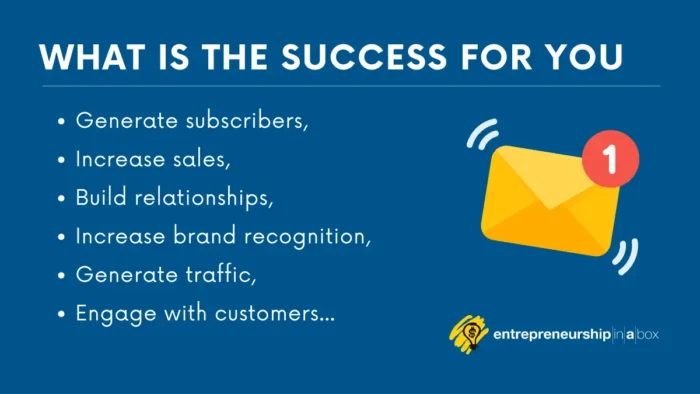
Step 2: Choose the Right Software
Remember that if you want to have effective email marketing campaigns, you must choose a better email service provider.
When you know what you want to accomplish with your email marketing campaigns, you will already have a picture of what each email will contain. This way, you can find different email service providers for that purpose.
Here are some tools that can do the work for you:
Three Great and Affordable Solutions
Aweber is a great tool for automation, easy-to-use templates, superior email deliverability, and extensive analytics for effective email marketing campaigns. If you have below 500 subscribers, you can test it for free and then upgrade anytime for more features.
ConvertKit has excellent automation features to help you create targeted email funnels that match your needs. It also provides detailed subscriber insights and easy integration with eCommerce platforms for advanced email marketing strategies.
GetResponse is a similar platform that offers powerful automation, comprehensive analytics, and user-friendly design tools for effective engagement and conversion strategies.
Other tools you can consider
SafeOpt can help you create a targeted campaign that automatically activates based on customer behavior.
For example, you can automatically send a discount code to customers who abandon their shopping carts or remind those who haven’t visited your site recently.
You can check the SafeOpt Reviews from SafeOpt customers, which are overwhelmingly positive.
Services like MassMailSoftware provide comprehensive solutions for this purpose. But be careful because one feature, email hunting, that allows you to search for emails on the web cannot be used without permission, especially if you haven’t given consent to send emails to these people.
If you are not using any specific software and want to send mass emails, you must ensure your messages are not in the Spam folder. Check out this article from Inboxally, which explains how to send mass emails without landing in the spam folder.
Another solution is the Emfluence marketing platform, which is more expensive but includes additional tools like social media marketing, CRM, SMS messaging, marketing calendar, etc.
Related: Chatbox 101: Understanding the Revolutionary Technology Behind the Conversational Revolution
Step 3: Know Your Audience

Do you really understand your subscribers?
In the beginning, I didn’t understand this question. So, one of my biggest mistakes was that my email subscribers were only on one list, not a segmented list.
As a result, they all got the same message, but my autoresponder did not always send relevant content to them.
In such a case, it doesn’t matter if they have subscribed for one or another reason; all of them will get the same messages.
Big mistake!
Remember that understanding your audience goes above identifying who they are.
It involves more deeply empathizing with their unique needs, preferences, and behaviors. So, the best thing you can do here is to create a buyer persona for each subscriber list.
If you know your audience, you can send personalized emails that are adjusted according to your specific subscribers’ needs.
No, I don’t discuss email personalization to address the recipient by their first name. This is expected, and all tools will give you this possibility.
You must personalize your emails based on the recipient’s interests, demographics, purchase history, and engagement in previous emails.
So, suppose you want to design an effective email marketing campaign. In that case, you must look at your analytics, conduct surveys, and collect feedback to create a detailed profile of the individuals receiving your messages.
For example, inside ConvertKit, you can tag your subscribers based on their clicked links. If their click means they are interested in a specific topic, we can tag the subscriber for those clicked topics.

In such a way, next time, you can send emails with specific topics only to subscribers tagged for those topics. This means your email marketing campaigns will be targeted campaigns.
Step 4: Design Your Processes for Each Email Campaign
This is important if you want a systematic approach to prevent you from losing yourself.
Each email campaign must have its own documented process. Here is a basic example to help you create your own processes.
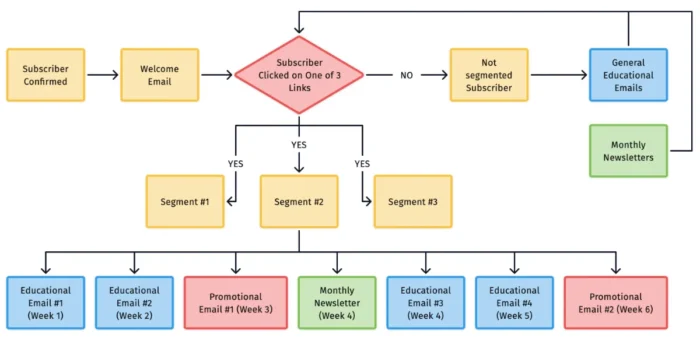
One of the most important questions to help you design your processes is, “What’s next?”
For example, let’s say:
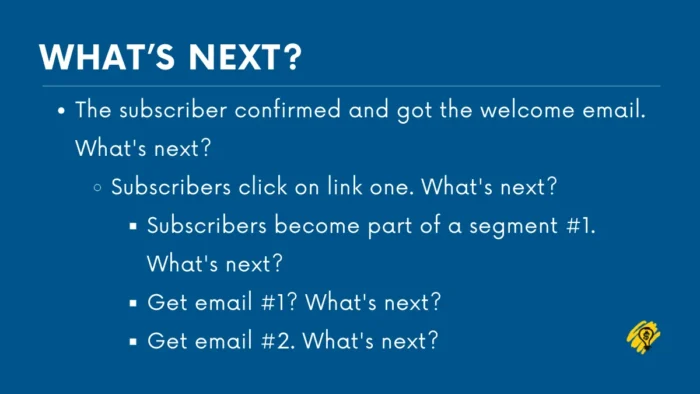
Can you see the logic behind this “what’s next?” question?
6 Steps to Increase Business Productivity Next Week
Step 5: Design Emails
Now that you have the processes for each email campaign, you can start working on the design and content of your emails.
There are several things you should consider if you want to have a successful email marketing campaign:
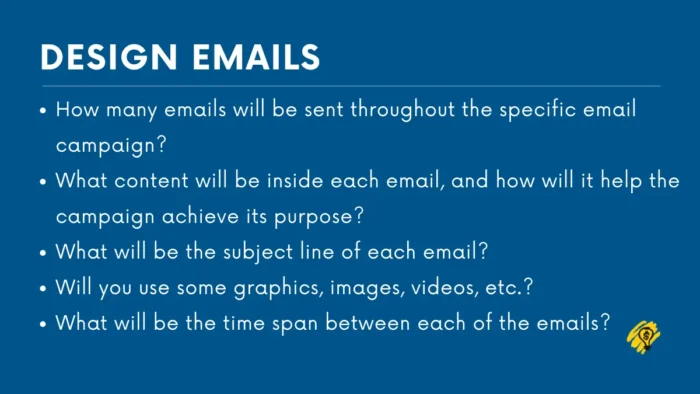
When you respond to these questions, you can start writing content for each email you want to send through your specific email campaign.
Related: 100+ Blog Post Ideas for Your Small Business Blog
Remember, one recent research conducted by Neil Patel shows that emails with 100 to 249 words perform best if you want to lead people to your website to take some specific action.
So, if you want to have a successful email marketing campaign, don’t overcomplicate your content. You must be clear and concise and stay on track with the primary purpose of your email campaign.
Step 6: Develop an Email Campaign Plan
At this step, you can start developing the plan.
I understand that planning does not bring results, but doing it will. But you must understand that spending more time planning makes you more likely to have a successful email campaign.
Let’s look at what your plan must contain:
1. Goals
Like with any other plan, you must start with defining specific, measurable, achievable, relevant, and time-bound (SMART) goals for your campaign.
For example, you can include:
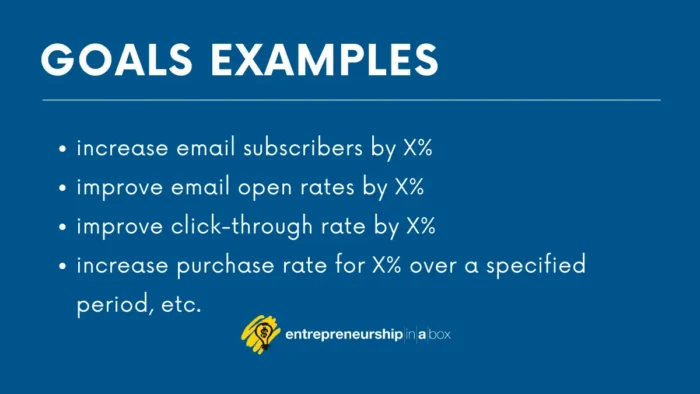
2. Tasks and Responsibilities
Now, you can define all the tasks that you or some of your team members will need to accomplish over a specified period of your campaign.
Open Excel or Google Sheets and write all the specific tasks that must be accomplished in the first column.
In the second column, you can assign clear roles and responsibilities to the team members who will be involved in the campaign.
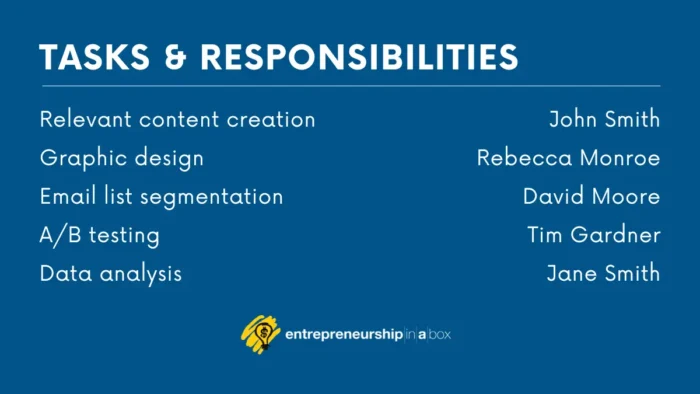
3. Key Performance Indicators (KPIs)
Next, your plan must respond to what specific metrics will be used to track the email campaign’s success about the goals you have set.
For example, you can use KPIs like open rates, click-through rates (CTR), conversion rates, bounce rates, and the campaign’s overall ROI.
4. Budget
Now, it would be great if you could determine the overall budget for the email campaign, including any necessary tools or software.
5. Timeline
Lastly, your plan must contain a realistic timeline for each stage of your email campaign, from planning to execution to analysis.
When you finish the planning process, you can execute your campaign.
Related: How to Start a Business With No Business Experience?
Step #7: A/B Testing
The biggest mistake you can make is to start the campaign and hope for the best.
Remember that your campaign must be a work in progress from start to finish.
So, always conduct A/B testing to improve your approach. A/B testing means sending the same email with different elements (email subject line, content, visuals, timing, etc.) to a subset of your email subscribers to see what performs better.
Then, when you compare the numbers from the test, you can send the better-performing email to the rest of the subscribers.
Today, most email service providers offer a feature that allows you to conduct A/B testing before sending emails to the whole list.
Step 8: Measure the Success of Your Email Campaign
One of the most important steps is monitoring the achievements of your email campaigns. You must look at:
- Open rate. How many people from the list opened the email you sent? What will happen if you change the subject line of the email?
- New subscribers. What’s going on if you change the landing page?
- Click-Through-Rates. What’s going on with clicks over time on different messages?
- Clicked links. What type of links brings more clicks?
- Unsubscribing rate. How many people unsubscribed from the list? When do they unsubscribe?
You must analyze these metrics to get important insights into what works and doesn’t.
So, never consider your campaign a failure but rather an opportunity to learn.
Step #9: Successful Email Campaigns Require Continuous Improvement
The last step concerns tweaking your email campaign based on what you’ve learned from in-depth analytics.
Here are some important elements that will require your focus for improvement:
Email subject lines
The email subject line is the first thing that your subscriber will see before he decides to open, archive, or delete the email. So, this is important if you want your subscriber to open and read the rest of the email’s content.
Look at your statistics to learn which subjects provide the best open rate and which had poor responses.
Improve all your poor subject lines to increase the open rate of your emails.
Headings in the rest of the email
After the subject line and a decision to open the message, the receiver does not start reading from the beginning to the end of the message. It scans the content; they will read it first if there are headings.
Because of that, you must examine all your headings and consider possible improvements that will encourage reading the whole message.
The content of the email
As we already discussed, the purpose of your email marketing campaign can be different.
The relevant content must be designed to encourage the achievement of your goals.
So, are there enough irresistible offers included in the content?
Is there a clear call to action?
Best timing to send email messages
Sometimes, sending emails at exactly the same time can result in a higher open rate.
So, look at your email marketing analytics and discover the best time to send your messages. It is important to ensure that most people rarely open your messages.
Discover the optimal times to catch your audience’s attention by testing different send times and measuring engagement levels.
Frequency of sending the emails
The higher unsubscription rate can be due to more frequent emails sent to your list.
So, you must find the optimal frequency that will allow you to send the maximum number of emails with the lowest possible unsubscription rate.
Social sharing
Look at your emails and ask yourself if they can be easily shared on social media. If not, it is time to include social media buttons in your messages to facilitate the receiver’s sharing options.
Another call to action is encouraging your readers to share the messages on social media.
Resegment your subscribers
What seriously annoys me is receiving too many emails without the basic reason I’ve opted into that list.
Look at your list to find the behavior of persons in terms of opened emails and opened links.
You can identify segments and improve the content for each segment. In such a way, you will have different email content for each segment.
5 Email Marketing Mistakes to Avoid
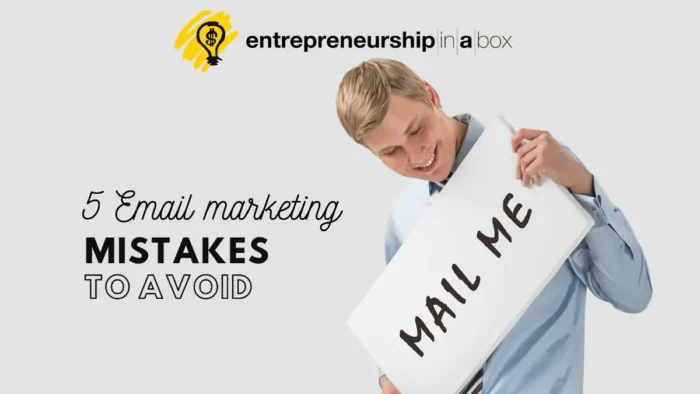
1. Using the wrong email marketing software
There are so many different pieces of marketing software available. How do you know which one is right for you? If you choose wrong, you might pay more than you should.
First, understand what you need. It’s tempting to start with the most comprehensive, expensive program that claims to do it all. However, if you’re starting to grow your email marketing efforts, you don’t need all of these extras that will drain your budget.
Instead, focus on an easy-to-use, scalable solution that can grow with your company without overcharging.
2. You don’t grow your email list
Strict anti-spam laws apply to sending emails, which you must consider. You can’t add people without their consent.
The best way to grow your email list isn’t to wait until people come to you.
The more proactive approach is to offer a lead magnet, or a freebie, that users can download in exchange for joining your email list. This can be anything from an online course to a discount code.
3. Wrong subject line
How many times have you deleted an email before even opening it?
Probably more times than you can count.
Boring subject lines produce boring results.
This means you must build trust and grab the reader’s attention with your subject line.
For instance, instead of sending the subject “Money Saving Tips,” use “Are you saving enough this month?” This question is more engaging and brings the user into the situation.
4. Your emails aren’t mobile-friendly
Most people read emails on their mobile devices nowadays. So, you must make your emails responsive.
If your emails are designed for big screens, this approach will not work. Instead, create emails that are perfect for screens of all sizes.
Learn how you can use video in your email marketing! Try and see.
5. You don’t automate
An automated, structured campaign is always a smarter idea.
With email automation, you create a funnel for your subscribers. When someone signs up, they receive an automated email series that nurtures them through sales.
Stay Compliant
Finally, you must consider some legal requirements regarding promotional emails.
1. Collecting customer data
Because you must collect and store customer data and information to send personalized promotional emails, you must ensure that you follow certain guidelines.
Many countries worldwide have their own privacy laws, so check up on your country of operation to ensure you’re within the guidelines and protecting your consumers.
2. Always offer consent options
Also, you must offer consent for all your practices and processes.
That includes people opting into what emails you offer, having options for what kind of information you can access and how you use it, or opting out of your email service anytime you please.
3. Don’t spam
Just as it’s illegal to falsely advertise a product you’re trying to sell, the same rules apply to your emails.
You need to ensure that you’re not misleading people into opening your emails using false headlines and subject lines and that you comply with anti-spam laws,
4. Don’t buy email lists
A quick way you may discover is to buy email lists of people whom you can then contact at any time.
However, there are many problems with this, mostly morally.
In addition to everything we’ve discussed above, you must ensure you obtain permission from these contacts to email them. Otherwise, you’ll be breaking CAN-SPAM laws.
5. Be transparent with your identity
You must always ensure you tell the people you’re emailing precisely who you are, and you should never try to hide it. This is according to CAN-SPAM laws and helps build trust with your customer base.
Tell them your physical location, perhaps your office address, and include a link to your website to ensure people can find out exactly who you are and why you’re emailing them.

